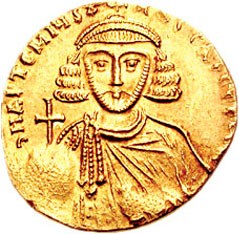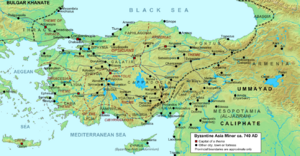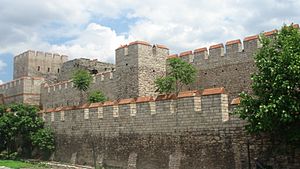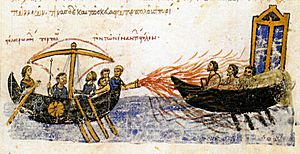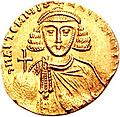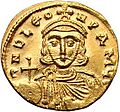Siege of Constantinople (717–718) facts for kids
Quick facts for kids Second Arab siege of Constantinople |
|||||||
|---|---|---|---|---|---|---|---|
| Part of the Arab–Byzantine wars and the early Muslim conquests | |||||||
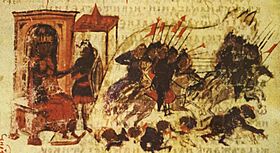 The second Arab siege of Constantinople, as depicted in the 14th-century Bulgarian translation of the Manasses Chronicle |
|||||||
|
|||||||
| Belligerents | |||||||
| Umayyad Caliphate | |||||||
| Commanders and leaders | |||||||
|
|||||||
| Strength | |||||||
| 120,000 (al-Mas'udi) 1,800 ships (Theophanes) |
c. 15,000 Byzantines (estimate) c. 12,000 Bulgars |
||||||
The second Arab siege of Constantinople was a huge attack by land and sea. It happened in 717–718. The Muslim Arabs of the Umayyad Caliphate tried to capture Constantinople. This city was the capital of the Byzantine Empire.
This attack was the end of twenty years of fighting. The Arabs had been slowly taking over Byzantine lands. The Byzantine Empire was also weak from many years of internal fighting. In 716, after a lot of planning, the Arabs invaded Asia Minor. Their leader was Maslama ibn Abd al-Malik. The Arabs hoped to use the Byzantine civil war to their advantage. They even teamed up with a general named Leo III the Isaurian. He was trying to become emperor. But Leo was clever and tricked them. He became the Byzantine emperor himself.
After spending the winter in Asia Minor, the Arab army moved into Thrace in the summer of 717. They built long walls to block Constantinople by land. The city was protected by the huge Theodosian Walls. The Arab fleet came with the army to block the city by sea. But the Byzantine navy used a secret weapon called Greek fire. This weapon destroyed many Arab ships. So, Constantinople could still get supplies by sea. Meanwhile, the Arab army suffered badly from famine and disease. The winter was unusually harsh. In spring 718, two more Arab fleets arrived to help. But their Christian sailors switched sides. The Byzantines then destroyed these fleets. Another Arab army coming by land was ambushed and defeated. The Bulgars also attacked the Arabs from behind. Because of all this, the Arabs had to give up the siege on August 15, 718. On their way home, a big storm destroyed almost all of the Arab fleet.
The failure of this siege had huge effects. Constantinople was saved, and the Byzantine Empire continued to exist. The Caliphate changed its plans. They still attacked Byzantine lands, but they gave up on trying to conquer the whole empire. Historians believe this siege was one of the most important battles in history. Its failure stopped the Muslim advance into Southeastern Europe for hundreds of years.
Contents
Why the Arabs Wanted Constantinople
After an earlier Arab attack on Constantinople (674–678), there was a time of peace. But after 680, the Umayyad Caliphate had its own civil war. The Byzantines became stronger in the East. They even made the Umayyad government pay them a lot of money. In 692, the Umayyads won their civil war. Emperor Justinian II then started fighting them again.
The Arabs won many battles. They took control of Armenia and other lands. Year after year, Arab generals raided Byzantine territory. They captured many forts and towns. After 712, the Byzantine defenses started to break down. Arab raids went deeper into Asia Minor. Border forts were attacked and looted. The Byzantines were also having a very unstable time. Their throne changed hands seven times in violent takeovers. This period is called the "Twenty Years' Anarchy."
Historians say that the Arab attacks would have grown stronger anyway. The Arabs had more people, land, and money than the Byzantines. They started to focus all their power on Byzantium. They now threatened to completely destroy the empire by capturing its capital city.
Preparing for the Big Attack
The Arab victories made it possible for them to attack Constantinople a second time. Caliph al-Walid I had already started planning this. After he died, his brother Sulayman became the new Caliph. He continued the plan with even more energy. Arab stories say this was because of a prophecy. It said a Caliph with a prophet's name would capture Constantinople. Sulayman (Solomon) was the only one in his family with such a name.
The Umayyad forces gathered in Syria. Caliph Sulayman was too sick to lead the army himself. So, he gave command to his brother Maslama ibn Abd al-Malik. This attack on Constantinople happened when the Umayyad empire was growing fast. Muslim armies were moving into Central Asia, India, and Spain.
The Byzantines were worried about the Arab preparations. They saw the Arabs building a huge fleet. Emperor Anastasius II sent a messenger to Damascus. He pretended to ask for peace. But his real mission was to spy on the Arabs. Anastasius then started to get ready for the siege. The city walls were repaired. They were also equipped with many catapults and other siege weapons. Food was brought into the city. People who could not store food for three years were told to leave.
Anastasius also made his navy stronger. In 715, he sent it to attack the Arab fleet. But the Byzantine fleet rebelled. They killed their commander and chose a tax collector named Theodosius as emperor. Anastasius tried to stop the rebellion. But the rebel fleet sailed to Chrysopolis, near Constantinople. From there, they attacked the capital. Finally, people inside Constantinople opened the gates to them. Anastasius gave up and became a monk.
Theodosius became emperor, but he seemed unwilling and not very capable. Other parts of the empire did not like this. Two powerful generals, Leo the Isaurian and Artabasdos, rose up.
While the Byzantines were fighting among themselves, the Arabs began their attack. In September 715, an Arab army marched into Asia Minor. They captured an important fort called Loulon. They spent the winter there. In early 716, this army continued into central Asia Minor. The Arab fleet sailed along the coast. Maslama waited with the main army in Syria.
The Arabs hoped that the Byzantine civil war would help them. Maslama had already talked with Leo the Isaurian. Some historians think Leo offered to become a vassal (a ruler under Arab control). But Leo probably just wanted to use the Arabs for his own plans. Maslama supported Leo. He hoped to cause more confusion and weaken the Byzantine Empire. This would make it easier to take Constantinople.
The Arabs first tried to capture Amorium. They wanted to use it as a base for the winter. Amorium was not defended well because of the civil war. It should have fallen easily. But the Arabs decided to help Leo instead. They offered to let the city surrender if its people would accept Leo as emperor. The city agreed, but still did not let the Arabs in. Leo came with a few soldiers. He used tricks and talks to get 800 of his men inside the city. The Arab army was stopped. They were also running out of supplies. So, they left. Leo went to Pisidia. In the summer, with Artabasdos's help, he was declared emperor. He openly challenged Theodosius.
Leo's success at Amorium happened at a good time. Maslama, with the main Arab army, had crossed the Taurus Mountains. He was marching straight for Amorium. The Arab general did not know that Leo had tricked him. So, he did not destroy the lands he marched through. He still thought their governors were his allies. When Maslama met the retreating Arab army, he learned what happened. He changed direction. He attacked Akroinon and then marched to the western coast for winter. On his way, he looted Sardis and Pergamon. The Arab fleet spent the winter in Cilicia.
Meanwhile, Leo marched on Constantinople. He captured Nicomedia. There, he found and captured Theodosius's son. Then he marched to Chrysopolis. In spring 717, after short talks, Theodosius gave up his throne. He recognized Leo as emperor. Leo entered the capital on March 25. Theodosius and his son were allowed to become monks. Artabasdos was given a high position and married Leo's daughter, Anna.
The Armies Ready for Battle
The Arabs prepared for a huge attack on Constantinople. Some old writings say the Arab army was "innumerable." Other sources claim 200,000 men and 5,000 ships. A 10th-century Arab writer said there were 120,000 troops. A Byzantine writer mentioned 1,800 ships. They gathered supplies for several years. They also brought siege weapons and materials to start fires. The supply train alone had 12,000 men, 6,000 camels, and 6,000 donkeys. Some troops were volunteers for a holy war.
The number of Byzantine defenders is not known. But Constantinople probably had no more than 15,000 men. The Byzantine Empire was tired from fighting. It was also hard to feed such a large force.
No matter the exact numbers, the attackers were much more numerous than the defenders. One historian said the Arab army might have been larger than the entire Byzantine army. Most of the Arab force came from Syria. These were experienced fighters and a strong part of the Umayyad government.
Even with the siege, the Caliphate still sent raids against the Byzantine border. In 717, the Caliph's son captured a fort. In 718, another general raided the border. On the Byzantine side, Emperor Leo had made a treaty with the Bulgar ruler Tervel. This treaty probably included an alliance against the Arabs.
The Siege Begins
In early summer, Maslama ordered his fleet to join him. His army crossed the Hellespont (a narrow strait) into Thrace. The Arabs began their march on Constantinople. They destroyed the countryside, gathered supplies, and looted towns. In mid-July or mid-August, the Arab army reached Constantinople. They completely cut off the city by land. They built two siege walls of stone. One faced the city, and one faced the countryside. Their camp was between these walls.
Arab sources say Leo offered to pay a gold coin for every person in the city to stop the attack. But Maslama replied that there could be no peace. He said the Arab soldiers for Constantinople were already chosen.
The Arab fleet arrived on September 1. It first anchored near the Hebdomon. Two days later, the fleet sailed into the Bosphorus strait. Different groups of ships anchored near the city's suburbs. Some ships went south to watch the southern entrance of the Bosphorus. The rest sailed past Constantinople. They landed on the coasts between Galata and Kleidion. This cut off Constantinople's connection to the Black Sea.
But as the last part of the Arab fleet passed the city, the wind changed. It pushed them towards the city walls. A Byzantine fleet attacked them with Greek fire. Some Arab ships sank with everyone on board. Others burned and drifted away. This victory encouraged the Byzantines. It made the Arabs feel defeated. The same night, Leo stretched a huge chain across the Golden Horn. This closed the entrance to the city's harbor. The Arab fleet did not want to fight the Byzantines anymore. They moved to a safer harbor further north.
The Arab army had many supplies. Arab stories say they had huge piles of food in their camp. They even brought wheat to plant and harvest later. But the Arab navy failed to block the city. This meant the Byzantines could still bring in supplies by sea. Also, the Arab army had already destroyed the countryside on its march. So, they could not find food there. The Arab fleet and a second Arab army could only bring limited supplies to Maslama's army.
As winter came, talks started between the two sides. Arab sources say Leo continued to trick the Arabs. One story says he tricked Maslama into giving him most of his grain. Another says he convinced Maslama to burn all his supplies. This was supposedly to make the city's people surrender. The winter of 718 was extremely harsh. Snow covered the ground for over three months. The Arab camp ran out of supplies. A terrible famine began. One historian claimed 300,000 Arabs died from hunger and disease.
The Arab situation seemed to improve in spring. The new Caliph, Umar II, sent two fleets to help. One had 400 ships from Egypt. The other had 360 ships from Africa. Both were full of supplies and weapons. At the same time, a new army marched through Asia Minor to help. When the new fleets arrived in the Sea of Marmara, they stayed away from the Byzantines. They anchored on the Asian shore.
However, most of the Arab sailors were Christian Egyptians. They started to desert and join the Byzantines. The Egyptians told Leo about the new Arab fleets. Leo then sent his fleet to attack them. The Arab ships were weak because their crews had left. They were also helpless against Greek fire. The Byzantines destroyed or captured the Arab ships, along with their weapons and supplies. Constantinople was now safe from a sea attack.
On land, the Byzantines also won. Their troops ambushed the advancing Arab army. They destroyed it in the hills south of Nicomedia.
Constantinople could now easily get supplies by sea. The city's fishermen went back to work. The Arab fleet did not sail again. The Arabs were still suffering from hunger and disease. They also lost a big battle against the Bulgars. According to one source, 22,000 Arabs died. The sources disagree on how the Bulgars helped. Some say the Bulgars attacked the Arab camp because of their treaty with Leo. Others say the Arabs went into Bulgar territory looking for food. Another source says the Bulgars fought the Arabs from the beginning. They attacked them as they marched through Thrace. The Bulgars continued to bother the Arab camps throughout the siege.
The siege had clearly failed. Caliph Umar sent orders for Maslama to retreat. After thirteen months, on August 15, 718, the Arabs left. This date was a special Christian holiday. The Byzantines believed the Virgin Mary helped them win. The retreating Arabs were not attacked. But their fleet lost more ships in a storm. Other ships caught fire from ash from the Thera volcano. Some survivors were captured by the Byzantines. One historian claimed only five Arab ships made it back to Syria. Arab sources say 150,000 Muslims died during the campaign. This number is probably too high, but it shows how big the disaster was.
What Happened After the Siege
The failure of this expedition weakened the Umayyad state. One historian said it was a serious blow to Umayyad power. The cost of the expedition put a huge strain on their money. This led to more problems and anger among the people. The destruction of the Syrian fleet and army also took away a main source of the Umayyad government's power.
The Caliphate was hit hard. Even though the land army did not lose as many men as the fleet, Caliph Umar thought about giving up recent conquests. He considered leaving Spain and Central Asia. He also thought about completely leaving Cilicia and other Byzantine lands the Arabs had taken. His advisors convinced him not to take such extreme steps. But most Arab soldiers were pulled back from the Byzantine border areas. In Cilicia, only one city remained in Arab hands. The Byzantines even got back some land in western Armenia for a while. In 719, the Byzantine fleet raided the Syrian coast. In 720 or 721, the Byzantines attacked a city in Egypt. Leo also got back control of Sicily. The governor there had tried to declare himself emperor.
Despite their victory, the Byzantines did not launch many attacks against the Arabs. In 720, Arab raids against Byzantium started again. But now, they were not trying to conquer. They were just looking for loot. The Arab attacks grew stronger over the next twenty years. This continued until a big Byzantine victory in 740. Along with military defeats on other fronts and internal problems, the age of Arab expansion ended.
Why This Siege Was So Important
The second Arab siege of Constantinople was much more dangerous than the first. This time, the Arabs launched a direct, well-planned attack. They tried to completely cut off the city by land and sea. The siege was the Caliphate's last big effort to "cut off the head" of the Byzantine Empire. If Constantinople fell, the other provinces would be easy to capture.
The Arabs failed mainly because of logistics. They were too far from their bases in Syria. But the Byzantine navy's use of Greek fire was also key. The strong walls of Constantinople and Leo III's cleverness also played important roles.
The failure of the Arab siege changed how Byzantium and the Caliphate fought. The Muslim goal of conquering Constantinople was given up. The border between the two empires became stable. It ran along the Taurus and Antitaurus Mountains. Both sides continued to raid each other. Towns and forts often changed hands. But the general border stayed the same for over two centuries. The eastern fleets of the Caliphate declined for a hundred years. Only the African fleets continued to raid Byzantine Sicily. After 752, these raids also stopped. No other Arab army would ever get close to Constantinople again.
Because of this, the Arab raids became almost like a ritual. They were seen as a way to show the ongoing holy war. The Caliph supported them as a symbol of his role as leader.
The outcome of the siege was very important for world history. Constantinople's survival protected the Byzantine Empire. It acted as a shield against Islamic expansion into Europe. This lasted until the city fell to the Ottoman Turks in the 15th century. Along with the Battle of Tours in 732, the successful defense of Constantinople helped stop Muslim expansion into Europe.
One historian wrote that if a victorious Caliph had made Constantinople the capital of Islam early in the Middle Ages, the effects on Christian Europe would have been huge. The Mediterranean Sea would have become an "Arab lake." Western European kingdoms would have been cut off from their cultural roots. Another historian said that by stopping the Muslim invasion, Europe stayed Christian. There was no serious Muslim threat to Europe until the 15th century. This victory, along with the Frankish victory at Tours, limited Islam's expansion in the west. Because of this, one historian called 718 "an ecumenical date." Military historians often include this siege in lists of the "decisive battles" of world history.
Stories and Legends
Among Arabs, the 717–718 siege became the most famous of their attacks on Byzantium. Many stories survive, but most were written later. They are often fictional and do not agree with each other. In legend, the defeat was turned into a victory. Maslama supposedly left only after riding into Constantinople with thirty men. Leo welcomed him with honor and took him to the Hagia Sophia. After Leo showed respect to Maslama and promised to pay tribute, Maslama and his troops left for Syria. The stories of the siege influenced other Arab epic tales. A siege of Constantinople appears in the Thousand and One Nights. Maslama and Caliph Sulayman also appear in a tale from the Hundred and One Nights. The commander of Maslama's guards, Abdallah al-Battal, became a famous hero in Arab and Turkish poetry.
Later Muslim and Byzantine stories also said that Maslama built Constantinople's first mosque. It was near the city's main government building. In reality, this mosque was probably built around 860. Ottoman stories also said Maslama built the Arap Mosque in Galata. But they wrongly dated this to around 686. This might have confused Maslama's attack with the first Arab siege in the 670s. The Arab army's passing also left marks at Abydos. A "Maslama's Well" and a mosque linked to him were still known there in the 10th century.
After their many failures at Constantinople, Muslims began to think the city would fall much later. So, the city's fall became one of the signs of the end times in Islamic beliefs. The siege also became a theme in Byzantine stories about the end of the world. Final battles against the Arabs outside Constantinople's walls appeared in old Greek writings.
Images for kids
See also
 In Spanish: Sitio de Constantinopla (717-718) para niños
In Spanish: Sitio de Constantinopla (717-718) para niños


